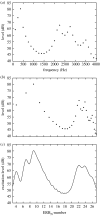Basic auditory processes involved in the analysis of speech sounds
- PMID: 17827102
- PMCID: PMC2606789
- DOI: 10.1098/rstb.2007.2152
Basic auditory processes involved in the analysis of speech sounds
Abstract
This paper reviews the basic aspects of auditory processing that play a role in the perception of speech. The frequency selectivity of the auditory system, as measured using masking experiments, is described and used to derive the internal representation of the spectrum (the excitation pattern) of speech sounds. The perception of timbre and distinctions in quality between vowels are related to both static and dynamic aspects of the spectra of sounds. The perception of pitch and its role in speech perception are described. Measures of the temporal resolution of the auditory system are described and a model of temporal resolution based on a sliding temporal integrator is outlined. The combined effects of frequency and temporal resolution can be modelled by calculation of the spectro-temporal excitation pattern, which gives good insight into the internal representation of speech sounds. For speech presented in quiet, the resolution of the auditory system in frequency and time usually markedly exceeds the resolution necessary for the identification or discrimination of speech sounds, which partly accounts for the robust nature of speech perception. However, for people with impaired hearing, speech perception is often much less robust.
Figures











Similar articles
-
Speech sound perception and learning: biologic bases.Scand Audiol Suppl. 1998;49:7-17. doi: 10.1080/010503998420603. Scand Audiol Suppl. 1998. PMID: 10209772
-
Segmental processing in the human auditory dorsal stream.Brain Res. 2008 Jul 18;1220:179-90. doi: 10.1016/j.brainres.2007.11.013. Epub 2007 Nov 17. Brain Res. 2008. PMID: 18096139 Review.
-
Speech sound perception, neurophysiology, and plasticity.Int J Pediatr Otorhinolaryngol. 1999 Feb 15;47(2):123-9. doi: 10.1016/s0165-5876(98)00130-x. Int J Pediatr Otorhinolaryngol. 1999. PMID: 10206359
-
Spectro-temporal modulation detection and its relation to speech perception in children with auditory processing disorder.Int J Pediatr Otorhinolaryngol. 2020 Apr;131:109860. doi: 10.1016/j.ijporl.2020.109860. Epub 2020 Jan 3. Int J Pediatr Otorhinolaryngol. 2020. PMID: 31958768
-
The auditory organization of complex sounds.Front Biosci. 2008 Jan 1;13:148-69. doi: 10.2741/2666. Front Biosci. 2008. PMID: 17981534 Review.
Cited by
-
[The systematic selection of speech audiometric procedures].HNO. 2017 Mar;65(3):219-227. doi: 10.1007/s00106-016-0249-0. HNO. 2017. PMID: 27742967 German.
-
Neural representation of spectral and temporal information in speech.Philos Trans R Soc Lond B Biol Sci. 2008 Mar 12;363(1493):923-45. doi: 10.1098/rstb.2007.2151. Philos Trans R Soc Lond B Biol Sci. 2008. PMID: 17827107 Free PMC article.
-
Stimulus change detection in phasic auditory units in the frog midbrain: frequency and ear specific adaptation.J Comp Physiol A Neuroethol Sens Neural Behav Physiol. 2013 Apr;199(4):295-313. doi: 10.1007/s00359-013-0794-x. Epub 2013 Jan 24. J Comp Physiol A Neuroethol Sens Neural Behav Physiol. 2013. PMID: 23344947 Free PMC article.
-
Listening to speech in the presence of other sounds.Philos Trans R Soc Lond B Biol Sci. 2008 Mar 12;363(1493):1011-21. doi: 10.1098/rstb.2007.2156. Philos Trans R Soc Lond B Biol Sci. 2008. PMID: 17827106 Free PMC article.
-
Frequency change detection and speech perception in cochlear implant users.Hear Res. 2019 Aug;379:12-20. doi: 10.1016/j.heares.2019.04.007. Epub 2019 Apr 17. Hear Res. 2019. PMID: 31035223 Free PMC article.
References
-
- Aibara R, Welsh J.T, Puria S, Goode R.L. Human middle-ear sound transfer function and cochlear input impedance. Hear. Res. 2001;152:100–109. doi:10.1016/S0378-5955(00)00240-9 - DOI - PubMed
-
- Alcántara J.I, Moore B.C.J, Vickers D.A. The relative role of beats and combination tones in determining the shapes of masking patterns at 2 kHz: I. Normal-hearing listeners. Hear. Res. 2000;148:63–73. doi:10.1016/S0378-5955(00)00114-3 - DOI - PubMed
-
- ANSI. American National Standards Institute; New York, NY: 1994. ANSI S1.1-1994. American national standard acoustical terminology.
-
- Bacon S.P, Viemeister N.F. Temporal modulation transfer functions in normal-hearing and hearing-impaired subjects. Audiology. 1985;24:117–134. - PubMed
-
- Brungart D.S, Simpson B.D, Darwin C.J, Arbogast T.L, Kidd G., Jr Across-ear interference from parametrically degraded synthetic speech signals in a dichotic cocktail-party listening task. J. Acoust. Soc. Am. 2005;117:292–304. doi:10.1121/1.1835509 - DOI - PubMed
Publication types
MeSH terms
LinkOut - more resources
Full Text Sources
Other Literature Sources

